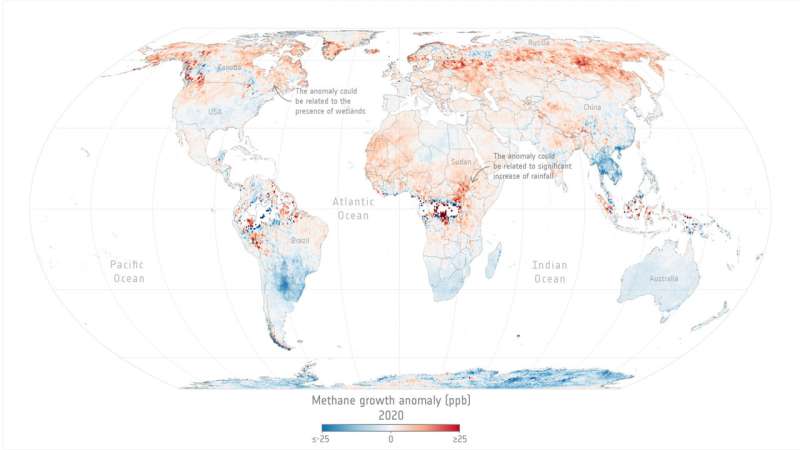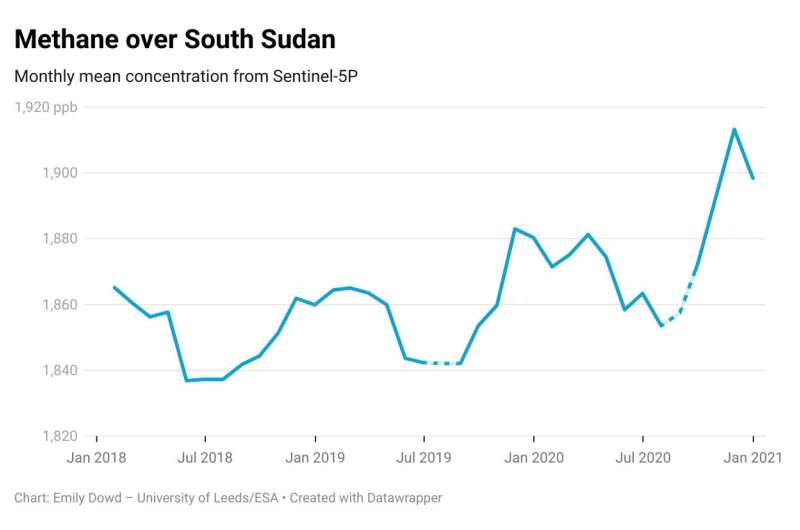Methane levels surged in 2020 despite lockdowns

Levels of methane, the second most important greenhouse gas in our atmosphere, continued their unrelenting rise in 2020 despite the economic slowdown caused by the COVID-19 pandemic.
A team of scientists, from the University of Leeds, have used data from the Copernicus Sentinel-5P satellite to pinpoint locations with large surges of methane emissions. These findings were presented during ESA's Living Planet Symposium which took place last month in Bonn, Germany.
Methane has a mixture of both natural and anthropogenic sources. Around 40% of methane emissions comes from natural sources, while 60% comes from anthropogenic sources such as agriculture, fossil fuel exploitation and landfills.
One of the largest sources of methane emissions comes from wetlands—an area of land that is either covered by water or saturated with water—yet there is still uncertainty in how they respond to changes in climate and short-term variations, such as the El Niño-Southern Oscillation.
The combination of methane's high global warming potential and relatively short lifetime in our atmosphere of approximately nine years, means if we reduce our methane emissions, we can partially mitigate the human impact of climate change on a relatively short timescale—while global emissions of carbon dioxide are reduced.
In situ methane measurements from 2020 showed the largest annual increase of methane concentrations since the 1980s, with this record surpassed in 2021. The year of 2020 was unique owing to the global pandemic, yet methane concentrations continued to rise despite a reduction in economic activity.
Anthropogenic emissions of methane have contributed to an additional 23% to the radiative forcing—a direct measure of the amount of Earth's energy budget that is out of balance—in the troposphere since 1750.

It is not fully understood what is driving the recent trends in global methane concentrations owing to the uncertainty surrounding the sources and sinks. This is why it is important to monitor changes in atmospheric methane using satellites such as Copernicus Sentinel-5P. The satellite maps a wide range of pollutants such as nitrogen dioxide, ozone, formaldehyde, sulfur dioxide, carbon monoxide, and of course, methane.
Using observations obtained from Sentinel-5P, the team found that satellite measurements show the same increase of methane as demonstrated in surface measurements. Using the global coverage capability of Sentinel-5P, the team identified regions which showed large increases throughout 2020.
These regions include South Sudan and Uganda in Central Africa, along with high-latitude northern regions including Canada and Russia. During 2019, emissions related to large positive rainfall anomalies from Sudd wetlands in South Sudan were found to be over a quarter of the growth in global emissions.
The positive rainfall anomalies over South Sudan and Uganda continued into 2020. In addition to large amounts of precipitation, there was a high rate of dam releases from Lake Victoria resulting in increased water flow into the White Nile which feeds the Ugandan and Sudd wetlands.
The data obtained from Sentinel-5P indicates that 2020 was likely to have been a period of large methane fluxes in these regions. Satellite data was also compared with a chemical transport model called TOMCAT, which simulates methane in our atmosphere.
In South Sudan, there is a mismatch in the seasonal cycle between the TOMCAT model and the satellite observations, which previous studies have related to the wetlands model used in the study. This implies that wetlands could be a dominant factor in driving the large methane concentrations over South Sudan during 2020.
In Canada, high concentrations of methane in 2020 are found in the east, where more wetlands are situated. The regions of strong methane growth measured in these satellite observations indicate that wetlands may have been significant contributors to the large rise in methane during 2020, however work using TOMCAT is still ongoing to further explore these findings.
Emily Dowd, Ph.D. student from the University of Leeds, said, "Copernicus Sentinel-5P observations have shown that global wetlands continue to be a large contributor to the atmospheric methane budget, and it is important that further work is carried out to fully understand how they will respond to changes in our climate."
Provided by European Space Agency



















